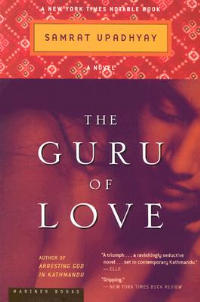 The Guru of Love
The Guru of Love

Set against a backdrop of prodemocracy unrest in contemporary Katmandu, The Guru of Love tells the story of a lowly tutor who ends up in a most irregular domestic mÚnage. Ramchandra lives in a shabby apartment house with his well-born wife and their children. He doesn't plan on becoming a cad, but when a beautiful young single mother named Malati becomes his student, he's drawn into a relationship with her. A powerful ambivalence marks his romance with the girl: "He had an urge to walk toward Tangal, knock on Malati's door, and tell her not to come to his house anymore, that he could no longer tutor her. Or perhaps crawl into bed next to her." When Ramchandra's wife Goma finds out about the affair, she has a unique solution--she asks Malati and her baby daughter to move into their apartment. Goma sleeps with the children and instructs the adulterous couple to share the master bedroom. She insists,: "Why don't you two go inside the bedroom, and I'll bring you some food." This license sits uneasily upon Ramchandra, much as democratic liberation sits uneasily upon the old city of Katmandu. The Guru of Love is ultimately a sweet, sad look at an indestructible family. It also gives us, in Ramchandra's wife Goma, a surprising, cunning, and altogether charming heroine. --Claire Dederer --This text refers to the Hardcover edition.
From Publishers Weekly
"The days crept on, and Goma and the children didn't come home. He felt their absence in his bones, his chest, the membranes of his throat so that at times it was difficult for him to speak." Yet Ramchandra, a math teacher in 1990s Nepal, is responsible for their absence. He has become infatuated with one of his tutees, 15-year-old single mother Malati. Unable to endure his obsession, his wife, Goma, has fled to her parents' home with pubescent Sanu and her younger brother, Rakesh. But nothing-neither infidelity nor her rich parents' scorn for a son-in-law who can barely afford a dilapidated apartment with outdoor plumbing-diminishes Goma's love for Ramchandra. Eventually, she returns home with the brilliant proviso that Malati and her infant move in as well, sleeping in the master bedroom with Ramchandra. Set in Kathmandu against a background of political upheaval, Upadhyay's debut novel (following the acclaimed short story collection Arresting God in Kathmandu) is stunning in its simplicity and emotional resonance. The language captivates the reader with its singular, intimate weave of English and Nepali. One experiences this book as Ramchandra experiences his life: not at a reflective distance but swept away by it. The background, too, is vivid: the social fabric of Kathmandu, particularly the turmoil of the pro-democracy movement and the growing urbanization of an ancient city, is conveyed with detailed realism. Upadhyay, who left Kathmandu for the U.S. at 21 and teaches in Cleveland, reminds us that stories grounded in a specific place and time are the most universal. The Nepali heart is the human heart. Goma, Ramchandra, Malati, the children and the beautifully drawn minor characters are at once themselves and all of us.
|
|

(aggiornata al 9 febbraio 2006)
Samrat Upadhyay is the first Nepali-born fiction writer writing in English to be published in the West. His first book, the short story collection ARRESTING GOD IN KATHMANDU (Houghton Mifflin, 2000; Houghton Mifflin Mariner Books paperback, 2001) has been translated into French and Greek and was the recipient of a Whiting Writers' Award, given annually by the Mrs. Giles Whiting Foundation to emerging poets and fiction writers who display "exceptional talent and promise." ARRESTING GOD IN KATHMANDU was also a selection in the Fall 2001 Barnes & Noble Great Writers Program. Upadhyay's stories have been read live on National Public Radio and published widely as well as in SCRIBNER'S BEST OF THE WRITING WORKSHOPS, edited by Sherman Alexie, and BEST AMERICAN SHORT STORIES 1999, edited by Amy Tan.
Upadhyay's second book, the novel THE GURU OF LOVE, was published in January 2003 by Houghton Mifflin and given starred reviews in both Publishers Weekly and The Library Journal and named a New York Times Notable Book of the Year 2003 and a finalist for the 2004 Kiriyama Prize, which is awarded in "recognition of outstanding books that promote greater understanding of and cooperation among the peoples and nations of the Pacific Rim and South Asia." THE GURU OF LOVE was released in paperback by Mariner Books/Houghton Mifflin in 2004. Upadhyay has also co-edited the anthology SECRET PLACES: NEW WRITING FROM NEPAL (University of Hawai'i Press), published in Winter 2001 as a special issue of Manoa magazine.
|